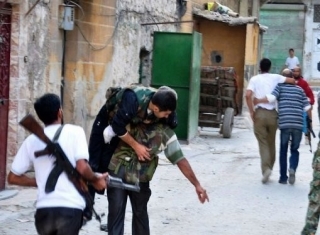New Rebel Offensive on Damascus to End up in Failure

 The Syrian and foreign rebels, who are conducting operations in several provinces of Syria, have once again tried to expand their field of action to the capital, Damascus, but they have failed to do so despite the support from Western and Arab media, which always refers to any one-time or limited rebel success as it was final and definitive. This media and the insurgent propaganda try to persuade the world, and specially the Qatari and Saudi sponsors of the armed groups, that the rebellion is booming.
The Syrian and foreign rebels, who are conducting operations in several provinces of Syria, have once again tried to expand their field of action to the capital, Damascus, but they have failed to do so despite the support from Western and Arab media, which always refers to any one-time or limited rebel success as it was final and definitive. This media and the insurgent propaganda try to persuade the world, and specially the Qatari and Saudi sponsors of the armed groups, that the rebellion is booming.
Most Western media uncritically reproduces statements made by the pro-rebellion London-based Syrian Observatory for Human Rights (SOHR) as they were proven facts. In recent days, the SOHR has suggested that Damascus is (once again) about to fall.
The Egyptian newspaper Al Ahram even claimed that “the inhabitants of the Syrian capital Damascus… are subjected to brutal attacks from military positions on the outskirts and Mount Qasiun overlooking the city”. Claims like this one sought to make the public believe that the rebels were already controlling a part of the city. The newspaper also repeated the rebels´ propaganda as a parrot: “The revolutionaries say that their advance on Damascus will trigger a mutiny by the army against its commanders. They hope that thousands will also defect from the regular army and argue that the establishment of a no-fly zone in the country would automatically bring this about.”
Friday 16 November was dubbed by the armed bands the “Friday of the Advance on Damascus”, indicating a “decisive battle” with the regime. They prepared their offensive and several groups arrived in the Damascus province from several places of Syria, such as Deraa and Deir Ezzor. It is, therefore, clear that the rebels attempted in November their most important effort against the capital since their failure of the summer. But this offensive, like the previous one, appears to have been thwarted.
Despite the Free Syrian Army (FSA)´s operations in some towns of the Damascus province, this group has at no time been able to enter the city. There have been clashes in the town of Daraya (South-West of the capital), the agricultural region of the Ghouta and the International Airport area (East). For the rebels, it was especially important to capture Daraya because of its strategic position: it oversees the important military airport of Mazzé.
The army´s counter-offensive
On 29 November, the Syrian army launched a vast operation of cleaning of these areas within a radius of 5 to 12 miles around the capital. They had been already cleaned last August, but the destruction of armed bands in a densely-inhabited zone is not an easy task.
The newspaper al-Watan announced on December 2 the army offensive against the places where terrorists had gathered together. “The Syrian army has opened since Thursday morning the gates of hell to all those who were thinking about approaching Damascus or launching an attack against the capital”, wrote the newspaper. It added that the government forces had inflicted heavy casualties on the rebels in several towns and villages.
After some days of offensive, the village of Daraya is now in the hands of the army. The town of Harasta, emptied of its inhabitants since it was invaded by the FSA, is also under the control of government forces while pockets of rebels remain in the nearby village of Duma.
In Ghouta, in the East, where the battle was at its peak this week around the International Airport, informed sources ensure that the airport and its surroundings have been secured, but gunfire can still be heard in distant regions. In the Sayyeda Zainab area, clashes persist between the pro-government militias protecting the district and armed groups holed up in the zone.
According to the Lebanese channel al-Mayadeen, which quoted a Syrian security official, the most violent combats took place on December 3. The site Syria Truth advanced the figure of 500 militiamen killed in the first four days of the army´s counter-offensive, including 40 in Deir al-Assafir, 30 in Nina al-Awamid, 60 in Shaba, 100 near the airport and 200 in the sector of Daraya. Al-Watan spoke of “hundreds of terrorists” killed in these days. On the other hand, the Syrian Air Force, indifferent to the threat of the fifty or so American surface-to-air missiles that the rebelds hold, continues its attacks on the rebel positions every day.
On the other hand, the limited strength of the rebels in the Damascus province, where they are only a few thousands, make them structurally unable to seriously threaten a city of more than two million inhabitants, where the government is, for obvious reasons, particularly powerful. Rebel advances are always precarious and the armed bands cannot resist the counter-attacks of the army and the militias fighting alongside with it. In this context, the new rebel offensive on Damascus is already becoming another resounding failure.







